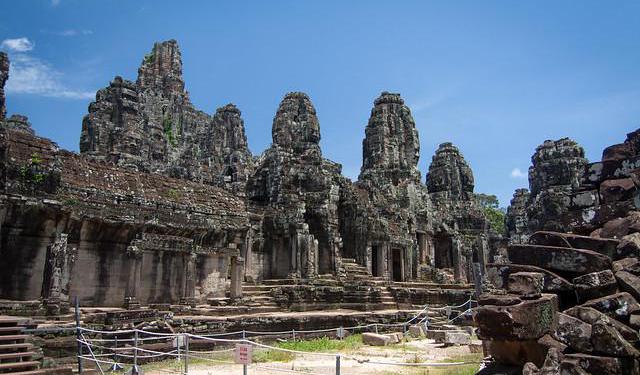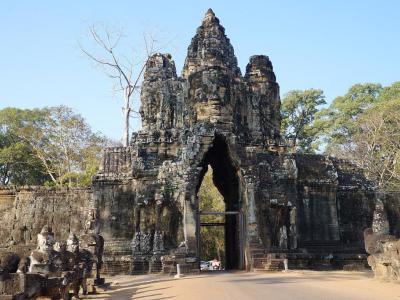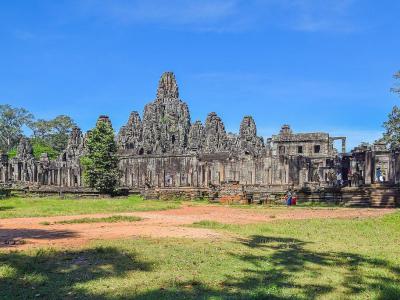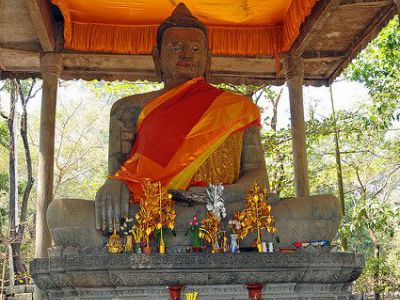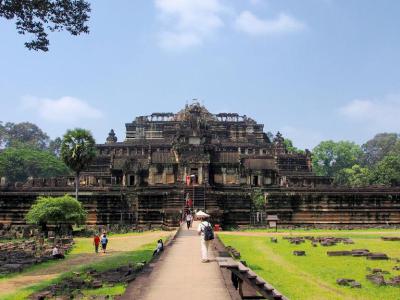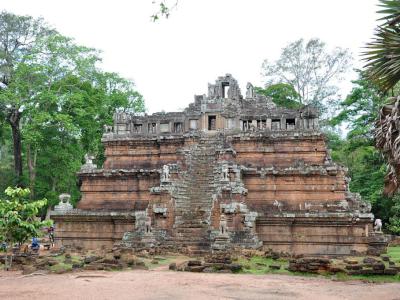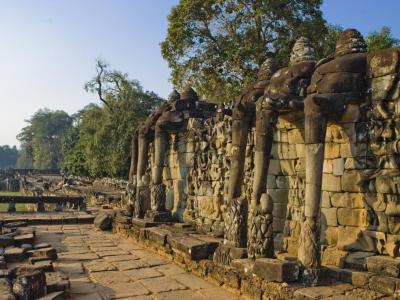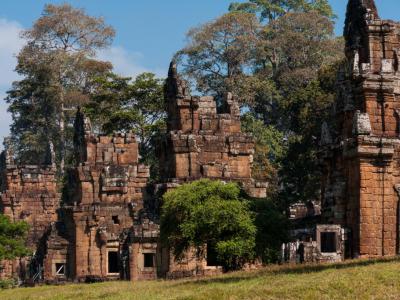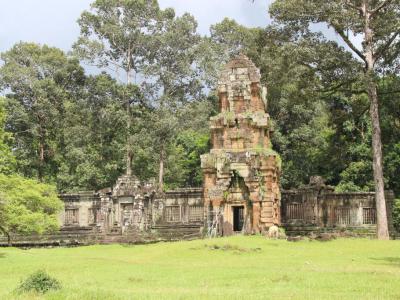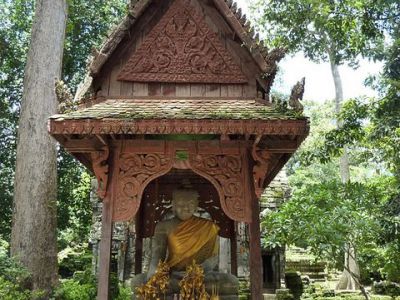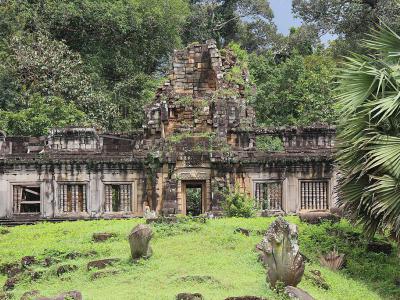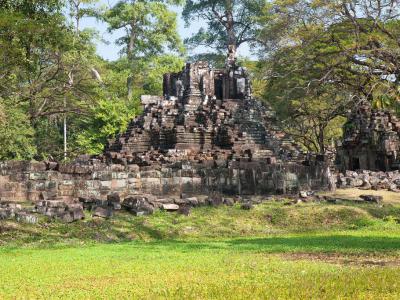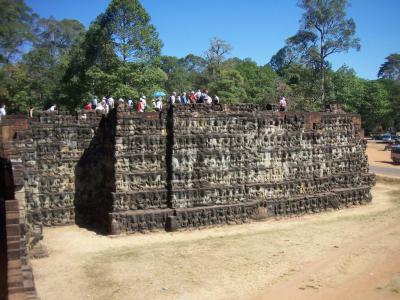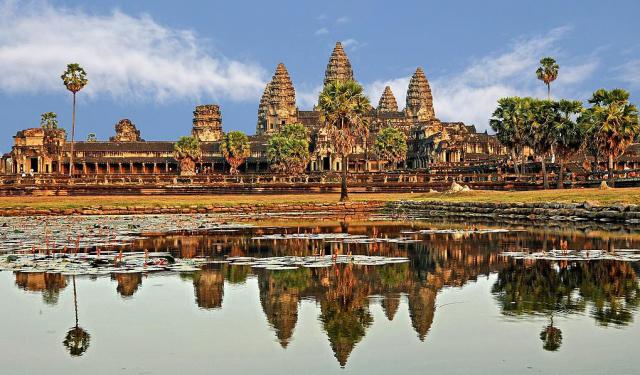Angkor Thom Walking Tour (Self Guided), Siem Reap
Nestled within the sprawling landscape of Siem Reap, Angkor Thom stands as a remarkable feat of ancient engineering and artistic expression. Built during the late 12th century by the Khmer King Jayavarman VII, this expansive city served as the capital of the Khmer Empire. Jayavarman VII's vision was to create a city that embodied the spiritual and cultural essence of the empire. Enclosed within colossal walls stretching over 8 meters high and surrounded by a moat, the city spanned an area of more than 9 square kilometers.
Remarkably, the existence of Angkor Thom remained largely hidden from the world until the 19th century. For centuries, this once-flourishing city lay concealed beneath layers of dense jungle foliage. It was the French naturalist and explorer Henri Mouhot whose expedition in the mid-1800s led to the rediscovery of Angkor Thom and its neighboring temples, including the illustrious Angkor Wat. Mouhot's writings and sketches brought to light the magnificence of these forgotten architectural gems, sparking global interest in the treasures of Cambodia's past.
Start your tour at South Gate, a portal flanked by stone figures of gods and demons, leading you into the heart of Angkor Thom. At the center of this architectural marvel lies the Bayon Temple, an iconic masterpiece renowned for its 54 towering stone towers adorned with serene, enigmatic faces. Each face, believed to depict Jayavarman VII himself, gazes in every direction.
Further north, you will encounter the imposing Baphuon, a pyramid-like temple with its intricate carvings hinting at the tales of an ancient world. Visit the Terrace of the Elephants, an elevated platform that once witnessed royal ceremonies and processions. While Preah Palilay is a serene sanctuary surrounded by lush greenery, offering a moment of serenity and reflection.
As you tread the paths once walked by kings, priests, and commoners alike, let your imagination run wild and your heart resonate with the echoes of a time long past. This self-guided walking tour is not merely a stroll through history; it is an immersive experience that invites you to connect with the soul of an ancient empire and its enduring legacy. Lace up your walking shoes and let the adventure unfold!
Remarkably, the existence of Angkor Thom remained largely hidden from the world until the 19th century. For centuries, this once-flourishing city lay concealed beneath layers of dense jungle foliage. It was the French naturalist and explorer Henri Mouhot whose expedition in the mid-1800s led to the rediscovery of Angkor Thom and its neighboring temples, including the illustrious Angkor Wat. Mouhot's writings and sketches brought to light the magnificence of these forgotten architectural gems, sparking global interest in the treasures of Cambodia's past.
Start your tour at South Gate, a portal flanked by stone figures of gods and demons, leading you into the heart of Angkor Thom. At the center of this architectural marvel lies the Bayon Temple, an iconic masterpiece renowned for its 54 towering stone towers adorned with serene, enigmatic faces. Each face, believed to depict Jayavarman VII himself, gazes in every direction.
Further north, you will encounter the imposing Baphuon, a pyramid-like temple with its intricate carvings hinting at the tales of an ancient world. Visit the Terrace of the Elephants, an elevated platform that once witnessed royal ceremonies and processions. While Preah Palilay is a serene sanctuary surrounded by lush greenery, offering a moment of serenity and reflection.
As you tread the paths once walked by kings, priests, and commoners alike, let your imagination run wild and your heart resonate with the echoes of a time long past. This self-guided walking tour is not merely a stroll through history; it is an immersive experience that invites you to connect with the soul of an ancient empire and its enduring legacy. Lace up your walking shoes and let the adventure unfold!
How it works: Download the app "GPSmyCity: Walks in 1K+ Cities" from Apple App Store or Google Play Store to your mobile phone or tablet. The app turns your mobile device into a personal tour guide and its built-in GPS navigation functions guide you from one tour stop to next. The app works offline, so no data plan is needed when traveling abroad.
Angkor Thom Walking Tour Map
Guide Name: Angkor Thom Walking Tour
Guide Location: Cambodia » Siem Reap (See other walking tours in Siem Reap)
Guide Type: Self-guided Walking Tour (Sightseeing)
# of Attractions: 12
Tour Duration: 3 Hour(s)
Travel Distance: 4.8 Km or 3 Miles
Author: vickyc
Sight(s) Featured in This Guide:
Guide Location: Cambodia » Siem Reap (See other walking tours in Siem Reap)
Guide Type: Self-guided Walking Tour (Sightseeing)
# of Attractions: 12
Tour Duration: 3 Hour(s)
Travel Distance: 4.8 Km or 3 Miles
Author: vickyc
Sight(s) Featured in This Guide:
- South Gate of Angkor Thom
- Bayon Temple
- Wat Preah Ngok (Temple of the Lead Buddha)
- Baphuon
- Phimeanakas (Celestial Palace)
- Terrace of the Elephants
- Prasat Suor Prat (Towers of the Rope Dancers)
- South Khleang (South Storehouse)
- Wat Preah Ang Sang Tuk (Monastery of the Buddha Footprint)
- North Khleang (North Storehouse)
- Preah Pithu (The Five Princes Temples)
- Terrace of the Leper King
1) South Gate of Angkor Thom
The South Gate of Angkor Thom stands as the most renowned city gate and serves as an emblematic representation of the grandeur of this ancient city. A must-see for every visitor to Angkor, the South Gate lies along the main road connecting Angkor Wat to another popular destination, the Bayon temple.
The causeway leading to the South Gate is a sight to behold, characterized by its exquisite stone causeway that spans the expansive 100-meter-wide moat of Angkor Thom. The railing on either side of the causeway is adorned with world-famous rows of giant sculptures, each holding a Naga, a multi-headed serpent, on their knees. These sculptures were once present at each of Angkor Thom's five city gates, but today, only the South Gate retains an almost complete set.
The eastern railing is adorned with 54 ferocious-looking Ashura demons, easily recognizable by their grimacing expressions. While some of the original heads have been moved to museums, the missing ones have been replaced with cement replicas, albeit of a brighter color. On the other side, the row of 54 Devas (gods) appears less well-preserved, with more heads missing. Both rows of sculptures are connected by a serpent-like rope held in their hands, creating a three-dimensional representation of the famous "Churning of the Milk Ocean" myth.
The "Churning of the Milk Ocean" is a revered narrative from Vishnu mythology, where Vishnu appeared as the turtle Kurma to assist in producing the elixir of immortality, the Amrita, for the gods. The story tells of the Devas and Ashuras, who united their forces to churn the Sea of Milk jointly, using Mount Mandara as the pivot, represented by the Bayon temple. The churning process led to the creation of various celestial treasures, including Apsaras (celestial dancers), the goddess Lakshmi, and the three-headed elephant Airavata, culminating in the discovery of the Amrita elixir.
The South Gate of Angkor Thom is not only a historical treasure but also a breathtaking representation of the region's myths and legends. Its impressive architecture and intricate sculptures captivate visitors, transporting them back in time to the ancient world of Angkor. The morning is recommended for a visit, as the faces of the demons are illuminated from the side, creating a unique play of light and shadow.
The causeway leading to the South Gate is a sight to behold, characterized by its exquisite stone causeway that spans the expansive 100-meter-wide moat of Angkor Thom. The railing on either side of the causeway is adorned with world-famous rows of giant sculptures, each holding a Naga, a multi-headed serpent, on their knees. These sculptures were once present at each of Angkor Thom's five city gates, but today, only the South Gate retains an almost complete set.
The eastern railing is adorned with 54 ferocious-looking Ashura demons, easily recognizable by their grimacing expressions. While some of the original heads have been moved to museums, the missing ones have been replaced with cement replicas, albeit of a brighter color. On the other side, the row of 54 Devas (gods) appears less well-preserved, with more heads missing. Both rows of sculptures are connected by a serpent-like rope held in their hands, creating a three-dimensional representation of the famous "Churning of the Milk Ocean" myth.
The "Churning of the Milk Ocean" is a revered narrative from Vishnu mythology, where Vishnu appeared as the turtle Kurma to assist in producing the elixir of immortality, the Amrita, for the gods. The story tells of the Devas and Ashuras, who united their forces to churn the Sea of Milk jointly, using Mount Mandara as the pivot, represented by the Bayon temple. The churning process led to the creation of various celestial treasures, including Apsaras (celestial dancers), the goddess Lakshmi, and the three-headed elephant Airavata, culminating in the discovery of the Amrita elixir.
The South Gate of Angkor Thom is not only a historical treasure but also a breathtaking representation of the region's myths and legends. Its impressive architecture and intricate sculptures captivate visitors, transporting them back in time to the ancient world of Angkor. The morning is recommended for a visit, as the faces of the demons are illuminated from the side, creating a unique play of light and shadow.
2) Bayon Temple (must see)
Bayon Temple is an iconic and intricately adorned Khmer temple. Constructed in the late 12th century or early 13th century, it served as the official state temple of King Jayavarman VII, a devout Mahayana Buddhist ruler, and was situated at the heart of his capital city, Angkor Thom. Over the centuries, the temple underwent modifications and additions by later Hindu and Theravada Buddhist kings, reflecting their religious inclinations.
The Bayon Temple is renowned for its most distinctive and captivating feature - the multitude of serene and massive stone faces adorning the numerous towers that rise from the upper terrace and cluster around its central peak. These enigmatic faces, believed to represent Avalokiteshvara or Jayavarman VII himself, exude an aura of calm and enigmatic power, adding to the temple's mystique and allure.
Beyond its iconic faces, the Bayon boasts two remarkable sets of bas-reliefs. These intricate carvings offer a unique combination of mythological, historical, and everyday scenes, providing valuable insights into the culture, history, and religious beliefs of the Khmer civilization.
The temple's architecture is a striking representation of the baroque style of Khmer architecture, setting it apart from the classical style of its neighboring temple, Angkor Wat. The Bayon's layout, with its maze of towers and intricate carvings, creates a mesmerizing visual spectacle that leaves visitors in awe of its grandeur and intricacy.
Over the years, the temple has undergone extensive restoration efforts to preserve its rich heritage. The Japanese Government team for the Safeguarding of Angkor (the JSA) has been actively involved in the conservation and restoration of this architectural marvel, ensuring that its splendor continues to be appreciated by generations to come.
The Bayon Temple is renowned for its most distinctive and captivating feature - the multitude of serene and massive stone faces adorning the numerous towers that rise from the upper terrace and cluster around its central peak. These enigmatic faces, believed to represent Avalokiteshvara or Jayavarman VII himself, exude an aura of calm and enigmatic power, adding to the temple's mystique and allure.
Beyond its iconic faces, the Bayon boasts two remarkable sets of bas-reliefs. These intricate carvings offer a unique combination of mythological, historical, and everyday scenes, providing valuable insights into the culture, history, and religious beliefs of the Khmer civilization.
The temple's architecture is a striking representation of the baroque style of Khmer architecture, setting it apart from the classical style of its neighboring temple, Angkor Wat. The Bayon's layout, with its maze of towers and intricate carvings, creates a mesmerizing visual spectacle that leaves visitors in awe of its grandeur and intricacy.
Over the years, the temple has undergone extensive restoration efforts to preserve its rich heritage. The Japanese Government team for the Safeguarding of Angkor (the JSA) has been actively involved in the conservation and restoration of this architectural marvel, ensuring that its splendor continues to be appreciated by generations to come.
3) Wat Preah Ngok (Temple of the Lead Buddha)
The Temple of the Lead Buddha, located just north of the Bayon, is a captivating historical site with a rich and intriguing history. It is one of the many Buddhist terraces attributed to the post-Angkor period, where recycled masonry from earlier ancient sites was used in its construction.
The temple features a simple yet grand terrace formed by a platform made of laterite blocks, measuring approximately 90 meters by 24 meters and rising about half a meter in height. On top of this platform lies an inner platform that reduces in size to around 50 meters by 10 meters. At the western end of this terrace stands a monumental Buddha statue, serving as the central focus of the site. The Buddha is gracefully covered by a shelter that has been restored in more recent times.
The Temple of the Lead Buddha is adorned with double sema stones, some of the largest seen in the Angkor region, placed at each cardinal point and corner of the terrace. Notably, the northwest sema stone bears an inscription from the French era of discovery, dating back to 1881. This inscription provides valuable historical context and insight into the site's exploration and documentation during that period. Additionally, the sema stone at the center of the western end carries an inscription for which the specific record remains elusive at present.
At the western end of the temple site, visitors can explore the remnants of a stepped laterite structure, believed to have possibly been a chedi or stupa. Sadly, little remains visible atop this structure today. However, stone coffins, lion pedestals, and other remnants have been thoughtfully arranged in this area, offering a glimpse into the site's past significance.
Nearby, two small reassembled stupas and two small sema stones can be found, adding further layers of historical intrigue to the site. Amongst the surrounding trees, the remains of a side building constructed of laterite are still visible, with only a sandstone window frame and base foundation remaining standing.
Throughout the area surrounding the Temple of the Lead Buddha, a vast array of sandstone pieces can be found, some of which are believed to originate from Baphuon. Among these sandstone remnants are curious stumpy round columns, which add to the enigmatic atmosphere of the site.
The temple features a simple yet grand terrace formed by a platform made of laterite blocks, measuring approximately 90 meters by 24 meters and rising about half a meter in height. On top of this platform lies an inner platform that reduces in size to around 50 meters by 10 meters. At the western end of this terrace stands a monumental Buddha statue, serving as the central focus of the site. The Buddha is gracefully covered by a shelter that has been restored in more recent times.
The Temple of the Lead Buddha is adorned with double sema stones, some of the largest seen in the Angkor region, placed at each cardinal point and corner of the terrace. Notably, the northwest sema stone bears an inscription from the French era of discovery, dating back to 1881. This inscription provides valuable historical context and insight into the site's exploration and documentation during that period. Additionally, the sema stone at the center of the western end carries an inscription for which the specific record remains elusive at present.
At the western end of the temple site, visitors can explore the remnants of a stepped laterite structure, believed to have possibly been a chedi or stupa. Sadly, little remains visible atop this structure today. However, stone coffins, lion pedestals, and other remnants have been thoughtfully arranged in this area, offering a glimpse into the site's past significance.
Nearby, two small reassembled stupas and two small sema stones can be found, adding further layers of historical intrigue to the site. Amongst the surrounding trees, the remains of a side building constructed of laterite are still visible, with only a sandstone window frame and base foundation remaining standing.
Throughout the area surrounding the Temple of the Lead Buddha, a vast array of sandstone pieces can be found, some of which are believed to originate from Baphuon. Among these sandstone remnants are curious stumpy round columns, which add to the enigmatic atmosphere of the site.
4) Baphuon
Baphuon is a magnificent temple that stands as a testament to the grandeur and architectural brilliance of the Khmer Empire. It was built in the mid-11th century during the reign of Udayadityavarman II as the state temple dedicated to the Hindu God Shiva.
The temple's design is that of a three-tiered temple mountain, commonly associated with the Baphuon style, which makes it an archetype of this architectural tradition. The temple's imposing presence and sacred purpose made it a significant religious and cultural center during its time.
With its base measuring 120 meters east-west and 100 meters north-south, Baphuon once stood an impressive 34 meters tall without its tower. If the tower were still intact, the temple's height would have reached approximately 50 meters, making it a colossal structure that impressed visitors throughout history.
During the late 13th century, the temple's appearance captivated Temür Khan's envoy, Chou Ta-kuan, during his visit from 1296 to 1297. He described Baphuon as the "Tower of Bronze," a truly astonishing spectacle with more than ten chambers at its base.
In the late 15th century, the temple underwent significant changes when it was converted to a Buddhist temple. A massive statue of a reclining Buddha, standing 9 meters tall and extending 70 meters in length, was constructed on the second level of the temple's west side. To make room for this immense statue, the 8-meter tower above was likely demolished, which explains its absence today.
The construction of Baphuon posed challenges due to its immense size and the land on which it was built, filled with sand. This instability caused portions of the temple to collapse throughout its history, and by the time the reclining Buddha was added, significant sections had already crumbled.
The temple's design is that of a three-tiered temple mountain, commonly associated with the Baphuon style, which makes it an archetype of this architectural tradition. The temple's imposing presence and sacred purpose made it a significant religious and cultural center during its time.
With its base measuring 120 meters east-west and 100 meters north-south, Baphuon once stood an impressive 34 meters tall without its tower. If the tower were still intact, the temple's height would have reached approximately 50 meters, making it a colossal structure that impressed visitors throughout history.
During the late 13th century, the temple's appearance captivated Temür Khan's envoy, Chou Ta-kuan, during his visit from 1296 to 1297. He described Baphuon as the "Tower of Bronze," a truly astonishing spectacle with more than ten chambers at its base.
In the late 15th century, the temple underwent significant changes when it was converted to a Buddhist temple. A massive statue of a reclining Buddha, standing 9 meters tall and extending 70 meters in length, was constructed on the second level of the temple's west side. To make room for this immense statue, the 8-meter tower above was likely demolished, which explains its absence today.
The construction of Baphuon posed challenges due to its immense size and the land on which it was built, filled with sand. This instability caused portions of the temple to collapse throughout its history, and by the time the reclining Buddha was added, significant sections had already crumbled.
5) Phimeanakas (Celestial Palace)
The Celestial Palace is a remarkable representation of the Khleang architectural style and holds significant historical importance dating back to the end of the 10th century.
The temple was initially built during the reign of King Rajendravarman, who ruled from 941 to 968. However, it was later completed and modified by King Suryavarman I, resulting in its unique three-tier pyramid shape. This transformation turned Phimeanakas into a splendid Hindu temple that served as a place of worship and devotion.
Atop the three-tier pyramid structure once stood a tower, which added to the temple's grandeur and spiritual significance. The temple's upper platform featured galleries, offering a space for devotees and visitors to explore and appreciate the intricately crafted sculptures and carvings.
The Celestial Palace is situated to the north of the famous Baphuon temple. This positioning suggests that the temple held a crucial role within the royal complex, possibly serving as a place of ceremonial importance for the Khmer rulers.
The temple was initially built during the reign of King Rajendravarman, who ruled from 941 to 968. However, it was later completed and modified by King Suryavarman I, resulting in its unique three-tier pyramid shape. This transformation turned Phimeanakas into a splendid Hindu temple that served as a place of worship and devotion.
Atop the three-tier pyramid structure once stood a tower, which added to the temple's grandeur and spiritual significance. The temple's upper platform featured galleries, offering a space for devotees and visitors to explore and appreciate the intricately crafted sculptures and carvings.
The Celestial Palace is situated to the north of the famous Baphuon temple. This positioning suggests that the temple held a crucial role within the royal complex, possibly serving as a place of ceremonial importance for the Khmer rulers.
6) Terrace of the Elephants
The Terrace of the Elephants is a remarkable archaeological site within the vast temple complex. It was an essential part of the grandeur of Angkor's king, Jayavarman VII's reign, serving multiple purposes during that time.
The terrace was originally constructed as a platform for King Jayavarman VII to observe and greet his victorious returning army. It was strategically attached to the palace of Phimeanakas, although only a few ruins of the once magnificent palace remain today. The majority of the original structure was built using organic materials, which have long since decayed, leaving behind the foundation platforms of the complex.
The name "Terrace of the Elephants" was derived from the remarkable carvings of elephants adorning its eastern face. These intricate carvings pay homage to the significance of elephants in the Khmer culture, symbolizing power, strength, and regal magnificence.
Stretching an impressive 350 meters in length, the Terrace of the Elephants served as a grand reviewing stand for various public ceremonies. It also functioned as the base for the king's grand audience hall, where he held important meetings and events. The terrace featured five outworks extending towards the Central Square - three in the center and one at each end, contributing to its monumental scale and architectural grandeur.
The middle section of the retaining wall was adorned with life-sized sculptures of mythical bird-like creatures and lions, adding an air of mythological significance to the site. Towards either end of the terrace, visitors can witness the renowned parade of elephants depicted in the carvings, complete with their elephant handlers.
The terrace was originally constructed as a platform for King Jayavarman VII to observe and greet his victorious returning army. It was strategically attached to the palace of Phimeanakas, although only a few ruins of the once magnificent palace remain today. The majority of the original structure was built using organic materials, which have long since decayed, leaving behind the foundation platforms of the complex.
The name "Terrace of the Elephants" was derived from the remarkable carvings of elephants adorning its eastern face. These intricate carvings pay homage to the significance of elephants in the Khmer culture, symbolizing power, strength, and regal magnificence.
Stretching an impressive 350 meters in length, the Terrace of the Elephants served as a grand reviewing stand for various public ceremonies. It also functioned as the base for the king's grand audience hall, where he held important meetings and events. The terrace featured five outworks extending towards the Central Square - three in the center and one at each end, contributing to its monumental scale and architectural grandeur.
The middle section of the retaining wall was adorned with life-sized sculptures of mythical bird-like creatures and lions, adding an air of mythological significance to the site. Towards either end of the terrace, visitors can witness the renowned parade of elephants depicted in the carvings, complete with their elephant handlers.
7) Prasat Suor Prat (Towers of the Rope Dancers)
The Towers of the Rope Dancers is a captivating series of twelve towers located on the eastern side of a royal square in the ancient city of Angkor Thom. Constructed with a combination of rugged laterite and sandstone, these enigmatic towers stand as intriguing enigmas from Cambodia's rich historical past.
Arranged symmetrically, the towers stretch from north to south, flanking the starting point of the road leading east to the Victory Gate. They stand proudly in front of the Terrace of the Elephants and the Terrace of the Leper King, adding to the grandeur of the surrounding area. Despite their prominence, the actual purpose of these towers remains a mystery, leaving historians and archaeologists intrigued.
Locally known as "The towers of the tightrope dancers," the name originates from a romantic notion that they were used to support high wires for acrobatic performances during royal festivals. However, this belief holds little relevance to their actual function. According to the records of Zhou Daguan, a Chinese diplomat who visited Angkor in the 13th century, the towers were used to settle disputes among the Angkorian people, suggesting a unique and practical application in the past.
The temple's construction is attributed to the reign of King Indravarman II, adding to the historical significance of these enigmatic towers. Among the twelve towers, N1 tower and N2 antechamber were facing the danger of collapse, prompting restoration efforts undertaken by the Japanese Government Team for the Safeguarding of Angkor from 2001 to 2005. The restoration work ensured the preservation of these ancient structures, allowing visitors to marvel at their architectural splendor today.
Arranged symmetrically, the towers stretch from north to south, flanking the starting point of the road leading east to the Victory Gate. They stand proudly in front of the Terrace of the Elephants and the Terrace of the Leper King, adding to the grandeur of the surrounding area. Despite their prominence, the actual purpose of these towers remains a mystery, leaving historians and archaeologists intrigued.
Locally known as "The towers of the tightrope dancers," the name originates from a romantic notion that they were used to support high wires for acrobatic performances during royal festivals. However, this belief holds little relevance to their actual function. According to the records of Zhou Daguan, a Chinese diplomat who visited Angkor in the 13th century, the towers were used to settle disputes among the Angkorian people, suggesting a unique and practical application in the past.
The temple's construction is attributed to the reign of King Indravarman II, adding to the historical significance of these enigmatic towers. Among the twelve towers, N1 tower and N2 antechamber were facing the danger of collapse, prompting restoration efforts undertaken by the Japanese Government Team for the Safeguarding of Angkor from 2001 to 2005. The restoration work ensured the preservation of these ancient structures, allowing visitors to marvel at their architectural splendor today.
8) South Khleang (South Storehouse)
South Storehouse is one of the two enigmatic structures known as the Khleangs, situated on the eastern side of the Royal Square in the ancient city of Angkor Thom. These buildings, whose purpose remains unknown, stand just behind the twelve towers of Prasat Suor Prat and are separated by the royal route that leads from the Angkor Thom Royal Palace to the Victory Gate.
The orientation of South Storehouse, along the north-south axis, reflects its deliberate alignment with the layout of the surrounding architectural marvels in Angkor Thom. Notably, the two Khleang buildings were not constructed simultaneously. The northern building, known as North Storehouse, was built during the reign of King Jayaviravarman, while the southern building, South Khleang, was constructed under the reign of his successor, King Suryavarman. Despite being built by different rulers, both structures share similar design characteristics, with South Storehouse being slightly narrower than its northern counterpart.
The Storehouses are notable for lending their name to the architectural style known as the Khleang style. This style is characterized by relatively simple lintels adorned with a central kala, which is a motif depicting a fierce mythical creature often associated with time and cosmic cycles. Other buildings in Angkor Thom that showcase the Khleang style include Phimeanakas and Ta Keo, further attesting to the prevalence and influence of this architectural design during the Khmer Empire's reign.
Although the original purpose of South Storehouse remains a mystery, its presence in the grand complex of Angkor Thom adds to the fascination and intrigue surrounding the site. Visitors can marvel at the architectural ingenuity of the Khmer civilization and ponder the historical significance of this enigmatic structure.
The orientation of South Storehouse, along the north-south axis, reflects its deliberate alignment with the layout of the surrounding architectural marvels in Angkor Thom. Notably, the two Khleang buildings were not constructed simultaneously. The northern building, known as North Storehouse, was built during the reign of King Jayaviravarman, while the southern building, South Khleang, was constructed under the reign of his successor, King Suryavarman. Despite being built by different rulers, both structures share similar design characteristics, with South Storehouse being slightly narrower than its northern counterpart.
The Storehouses are notable for lending their name to the architectural style known as the Khleang style. This style is characterized by relatively simple lintels adorned with a central kala, which is a motif depicting a fierce mythical creature often associated with time and cosmic cycles. Other buildings in Angkor Thom that showcase the Khleang style include Phimeanakas and Ta Keo, further attesting to the prevalence and influence of this architectural design during the Khmer Empire's reign.
Although the original purpose of South Storehouse remains a mystery, its presence in the grand complex of Angkor Thom adds to the fascination and intrigue surrounding the site. Visitors can marvel at the architectural ingenuity of the Khmer civilization and ponder the historical significance of this enigmatic structure.
9) Wat Preah Ang Sang Tuk (Monastery of the Buddha Footprint)
Monastery of the Buddha Footprint is an active monastery. The site boasts a combination of ancient remnants and reconstructed structures, making it a fascinating destination for visitors interested in the historical and religious significance of the region.
At the heart of the Monastery of the Buddha Footprint is a large reconstructed terrace, which serves as a focal point of the complex. This terrace holds special importance, as it houses a monumental Buddha statue that stands as a symbol of reverence and devotion. The terrace is beautifully adorned with ornately capped double sema, which serve as sacred markers, demarcating the holy area within the complex.
To the west of the reconstructed terrace, visitors can explore two ancient laterite constructions. One of these structures is the remains of a square construction, open to the east and accessible by a flight of stairs. Adjacent to the square construction is an octagonal-shaped laterite structure, which has recently undergone partial restoration. This restoration work has revealed its intricate design and architectural beauty, adding to the allure of the site.
Among the discoveries made at Wat Preah Ang Sang Tuk is a sandstone dharmacakra, a significant symbol in Buddhist iconography representing the Wheel of Dharma and the teachings of the Buddha.
Interestingly, historical records indicate that early French maps referred to the site as Terrace No. 2. This suggests that Monastery of the Buddha Footprint is one of the many Buddhist terraces found within the sprawling complex of Angkor Thom, underscoring its historical and cultural importance in the region.
Today, Wat Preah Ang Sang Tuk stands as a living testament to Cambodia's rich religious heritage. As a functioning monastery, it continues to serve as a place of worship and spiritual contemplation, drawing both local devotees and curious travelers seeking to connect with the profound history and spiritual essence of the Khmer civilization. Visitors to this site can immerse themselves in its serene ambiance, explore the remnants of ancient structures, and marvel at the reconstructed terrace and its monumental Buddha statue, making it a truly enriching experience for all who visit.
At the heart of the Monastery of the Buddha Footprint is a large reconstructed terrace, which serves as a focal point of the complex. This terrace holds special importance, as it houses a monumental Buddha statue that stands as a symbol of reverence and devotion. The terrace is beautifully adorned with ornately capped double sema, which serve as sacred markers, demarcating the holy area within the complex.
To the west of the reconstructed terrace, visitors can explore two ancient laterite constructions. One of these structures is the remains of a square construction, open to the east and accessible by a flight of stairs. Adjacent to the square construction is an octagonal-shaped laterite structure, which has recently undergone partial restoration. This restoration work has revealed its intricate design and architectural beauty, adding to the allure of the site.
Among the discoveries made at Wat Preah Ang Sang Tuk is a sandstone dharmacakra, a significant symbol in Buddhist iconography representing the Wheel of Dharma and the teachings of the Buddha.
Interestingly, historical records indicate that early French maps referred to the site as Terrace No. 2. This suggests that Monastery of the Buddha Footprint is one of the many Buddhist terraces found within the sprawling complex of Angkor Thom, underscoring its historical and cultural importance in the region.
Today, Wat Preah Ang Sang Tuk stands as a living testament to Cambodia's rich religious heritage. As a functioning monastery, it continues to serve as a place of worship and spiritual contemplation, drawing both local devotees and curious travelers seeking to connect with the profound history and spiritual essence of the Khmer civilization. Visitors to this site can immerse themselves in its serene ambiance, explore the remnants of ancient structures, and marvel at the reconstructed terrace and its monumental Buddha statue, making it a truly enriching experience for all who visit.
10) North Khleang (North Storehouse)
The North Storehouse is a captivating small cruciform structure. It is positioned at the northeast side of the royal plaza, nestled behind the row of Prasat Suor Prat towers, adding to its historical significance and charm.
Despite being referred to as a storehouse, the exact purpose of North Storehouse remains a mystery. Various hypotheses have been put forward by historians and archaeologists, but none have been conclusively proven. One theory suggests that it might have served as a reception hall for dignitaries visiting the royal court, providing a grand space for official ceremonies and meetings.
Another possibility is that it was utilized as a residence for princes or high-ranking court officials, offering a place of dwelling in close proximity to the royal activities. However, the narrowness of the structure has led to some skepticism regarding these theories. With a width of only 4.7 meters, it appears less likely that it could have been used for grand receptions or as a comfortable residence.
Historical records indicate that North Storehouse was constructed during the reign of King Jayaviravarman, further linking it to the fascinating history of the Khmer Empire. The Khmer rulers were known for their architectural marvels, and North Khleang is no exception, showcasing the exceptional craftsmanship and attention to detail that characterized the era.
Despite being referred to as a storehouse, the exact purpose of North Storehouse remains a mystery. Various hypotheses have been put forward by historians and archaeologists, but none have been conclusively proven. One theory suggests that it might have served as a reception hall for dignitaries visiting the royal court, providing a grand space for official ceremonies and meetings.
Another possibility is that it was utilized as a residence for princes or high-ranking court officials, offering a place of dwelling in close proximity to the royal activities. However, the narrowness of the structure has led to some skepticism regarding these theories. With a width of only 4.7 meters, it appears less likely that it could have been used for grand receptions or as a comfortable residence.
Historical records indicate that North Storehouse was constructed during the reign of King Jayaviravarman, further linking it to the fascinating history of the Khmer Empire. The Khmer rulers were known for their architectural marvels, and North Khleang is no exception, showcasing the exceptional craftsmanship and attention to detail that characterized the era.
11) Preah Pithu (The Five Princes Temples)
The Five Princes Temples is a fascinating group of five temples located in the historical complex in Angkor Thom, to the northeast of the renowned Bayon Temple and in front of Tep Pranam. These temples hold a unique charm due to their close proximity and intriguing historical background.
The five temples that constitute the complex were not constructed simultaneously, with the exception of two of them, resulting in a lack of apparent chronological order. Each temple is identified by a letter: T, U, V, W, and X. Among them, Temple "X" stands out as a Buddhist temple, although it remains unfinished and is believed to be the most recent addition to the group.
While Temple "X" remains incomplete, the other four temples are dedicated to Hindu deities, reflecting the religious diversity that characterized the Khmer Empire during its reign. Despite the passage of time, these temples have faced significant deterioration, particularly on their upper levels, leaving them in a state of ruin. However, what remains of their intricate carvings is a testament to the exceptional craftsmanship of the ancient Khmer artisans, offering visitors a glimpse into the artistic brilliance of the past.
What makes The Five Princes Temples a unique destination for travelers is its tranquil and serene ambiance. The site is relatively peaceful and less crowded, allowing visitors to explore the remnants of these ancient temples amidst a wooded landscape. The surrounding moat, though often dry, adds to the historical charm and mystique of the place.
In the early 20th century, efforts were made to preserve and restore The Five Princes Temples. Jean Commaille commenced the cleaning process in 1908, followed by Henri Marchal, who diligently worked on the restoration from 1918 to 1920. Their endeavors helped in safeguarding the architectural and artistic legacy of this remarkable group of temples.
The five temples that constitute the complex were not constructed simultaneously, with the exception of two of them, resulting in a lack of apparent chronological order. Each temple is identified by a letter: T, U, V, W, and X. Among them, Temple "X" stands out as a Buddhist temple, although it remains unfinished and is believed to be the most recent addition to the group.
While Temple "X" remains incomplete, the other four temples are dedicated to Hindu deities, reflecting the religious diversity that characterized the Khmer Empire during its reign. Despite the passage of time, these temples have faced significant deterioration, particularly on their upper levels, leaving them in a state of ruin. However, what remains of their intricate carvings is a testament to the exceptional craftsmanship of the ancient Khmer artisans, offering visitors a glimpse into the artistic brilliance of the past.
What makes The Five Princes Temples a unique destination for travelers is its tranquil and serene ambiance. The site is relatively peaceful and less crowded, allowing visitors to explore the remnants of these ancient temples amidst a wooded landscape. The surrounding moat, though often dry, adds to the historical charm and mystique of the place.
In the early 20th century, efforts were made to preserve and restore The Five Princes Temples. Jean Commaille commenced the cleaning process in 1908, followed by Henri Marchal, who diligently worked on the restoration from 1918 to 1920. Their endeavors helped in safeguarding the architectural and artistic legacy of this remarkable group of temples.
12) Terrace of the Leper King
The Terrace of the Leper King, situated in the northwest corner of the Royal Square of Angkor Thom is a fascinating and historically significant monument. The terrace was constructed in the Bayon architectural style during the reign of King Jayavarman VII, a period known for its remarkable architectural achievements.
The modern name of the terrace is derived from a sculpture discovered at the site in the 15th century. This sculpture portrays the Hindu god Yama, who is known as the god of Death in Hindu mythology. The statue earned its association with the Leper King due to the appearance of discoloration and moss growth on its surface, which resembled the physical symptoms of leprosy. Additionally, the name seemed to align with a Cambodian legend about an Angkorian king who suffered from leprosy.
Despite the association with leprosy, the original name inscribed at the bottom of the statue was "Dharmaraja." This name, which translates to "King of Dharma" or "Righteous King," is a reflection of the god Yama's role as the divine judge who weighs a person's good and bad deeds after death.
The Terrace of the Leper King is an exceptional architectural masterpiece that showcases the artistic prowess of the Khmer civilization. As part of the Angkor Thom complex, it holds a significant place in Cambodian history and culture. The terrace features intricate carvings and decorative elements that highlight the influence of Hindu mythology and religious beliefs prevalent during the Khmer Empire.
The modern name of the terrace is derived from a sculpture discovered at the site in the 15th century. This sculpture portrays the Hindu god Yama, who is known as the god of Death in Hindu mythology. The statue earned its association with the Leper King due to the appearance of discoloration and moss growth on its surface, which resembled the physical symptoms of leprosy. Additionally, the name seemed to align with a Cambodian legend about an Angkorian king who suffered from leprosy.
Despite the association with leprosy, the original name inscribed at the bottom of the statue was "Dharmaraja." This name, which translates to "King of Dharma" or "Righteous King," is a reflection of the god Yama's role as the divine judge who weighs a person's good and bad deeds after death.
The Terrace of the Leper King is an exceptional architectural masterpiece that showcases the artistic prowess of the Khmer civilization. As part of the Angkor Thom complex, it holds a significant place in Cambodian history and culture. The terrace features intricate carvings and decorative elements that highlight the influence of Hindu mythology and religious beliefs prevalent during the Khmer Empire.
Walking Tours in Siem Reap, Cambodia
Create Your Own Walk in Siem Reap
Creating your own self-guided walk in Siem Reap is easy and fun. Choose the city attractions that you want to see and a walk route map will be created just for you. You can even set your hotel as the start point of the walk.
Siem Reap Introduction Walking Tour
As the gateway to the magnificent Angkor Archaeological Park, Siem Reap holds within its bounds an extraordinary blend of ancient temples, bustling markets, and vibrant neighborhoods.
Siem Reap's history dates back to the 9th century when it emerged as a small village near the Siem Reap River. Its name, meaning "Defeat of Siam," pays homage to a victorious battle fought against... view more
Tour Duration: 2 Hour(s)
Travel Distance: 2.8 Km or 1.7 Miles
Siem Reap's history dates back to the 9th century when it emerged as a small village near the Siem Reap River. Its name, meaning "Defeat of Siam," pays homage to a victorious battle fought against... view more
Tour Duration: 2 Hour(s)
Travel Distance: 2.8 Km or 1.7 Miles
The Most Popular Cities
/ view all
